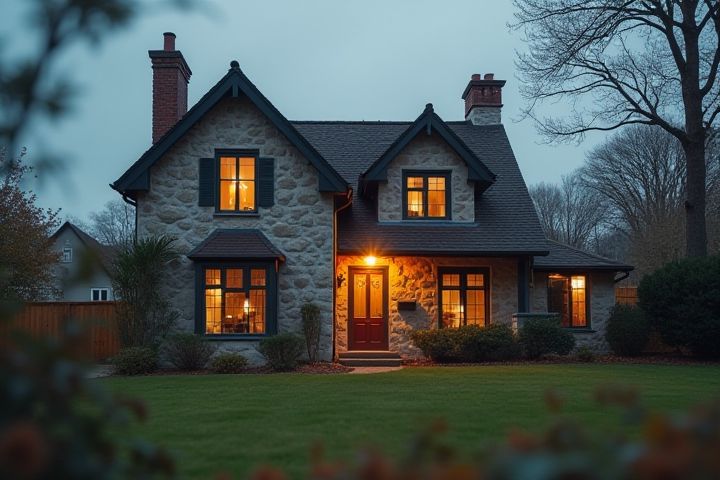
Houses can make noise due to various factors, including structural settling, temperature fluctuations, and environmental changes. The expansion and contraction of materials, such as wood and metal, in response to heat and cold can create popping or creaking sounds. Plumbing pipes may also contribute noise, particularly when water flows through them, causing vibrations. Furthermore, the presence of pests, such as rodents or insects, can lead to scratching or scurrying sounds within walls or attics. If you're concerned about unusual noises, it's wise to investigate their source to prevent potential damage or issues.
Why A House Makes Noise
Temperature changes
Temperature changes can cause various materials in your house to expand and contract, leading to noises that may catch your attention. For instance, wooden beams and floorboards can produce creaking sounds as they adjust to fluctuating temperatures, especially when moving from warm to cooler conditions. Similarly, metal pipes might create clanging or clicking noises during heating cycles due to thermal expansion. This acoustic activity is more pronounced in extreme weather, where temperature swings exceed 20 degrees Fahrenheit, resulting in heightened sound dynamics throughout your home.
Humidity fluctuations
Humidity fluctuations can cause various materials in your house, such as wood and drywall, to expand or contract, resulting in audible sounds. For instance, when humidity levels rise, wooden floors may swell, causing creaking sounds as they press against each other. Conversely, during dry conditions, these materials can shrink, leading to popping noises as they pull apart. Understanding the impact of humidity on your home can help you manage these noises effectively, ensuring a more comfortable living environment.
Settling foundation
A house makes noise due to the settling of its foundation, which is a common phenomenon observed in newly built or older homes. As the soil beneath your house compresses over time, the materials may shift, leading to creaks, pops, or groans that can resonate through the structure. Changes in moisture levels, temperature fluctuations, and seasonal shifts can also contribute to the expansion and contraction of materials, amplifying these sounds. Understanding that some noise is a natural part of a house's settling can help you distinguish between normal occurrences and potential structural issues requiring attention.
Expanding/contracting materials
Houses often make noises due to the expansion and contraction of building materials in response to temperature changes. As temperatures rise, wooden beams and floorboards can expand, creating creaking sounds, while cooler temperatures cause them to contract, resulting in popping noises. Metal components, such as pipes and HVAC ducts, also react to heat fluctuations, producing clicking or banging sounds as they adjust. Understanding these natural behaviors can help you distinguish between typical settling noises and potential structural issues in your home.
Plumbing vibrations
Plumbing vibrations, often caused by water flowing through pipes, can lead to noticeable noises in your house. When water pressure fluctuates, it creates movement in the pipes, resulting in sounds like banging or vibrating. This phenomenon, sometimes referred to as "water hammer," can occur if air chambers in the plumbing system are filled with water, preventing them from absorbing shock. Regular maintenance, such as ensuring proper pipe insulation and checking water pressure, can help mitigate these disturbances, enhancing your home's comfort.
HVAC system operation
HVAC systems often produce noise during operation due to various mechanical processes, including the expansion and contraction of metal components, which can create popping or banging sounds. The blower fan, responsible for circulating air, usually generates a consistent hum, while ductwork may vibrate or rattle as air pressure changes, potentially resulting in clanking noises. Debris in the system, such as leaves or dirt, can cause whistling or hissing sounds as air flows past obstructions. Regular maintenance, including filter changes and duct cleaning, is crucial to minimizing these noises and ensuring efficient system performance.
Wind impact
Wind can cause a house to make various noises, primarily due to pressure fluctuations and structural motion. When strong winds blow against your home, they can create vibrations in the walls, windows, and roof, leading to creaks or rattles. The movement of air around the structure can also result in whistling sounds as it passes through small openings or around fixtures. Understanding these wind-induced noises can help you assess whether they are normal or indicate a need for repairs, particularly if your home experiences gusts exceeding 25 mph frequently.
Rodent or pest activity
Rodents and other pests can cause a variety of noises in your house, often indicative of their presence. Scratching sounds in walls or ceilings typically suggest rodents such as mice or rats moving through insulation or searching for food. Chewing noises may indicate pests gnawing on wood, wires, or even drywall, which can potentially lead to structural damage or fire hazards. Active at night, these pests can create disturbances that may interrupt your sleep, prompting the need for pest control solutions to protect your home environment.
Structural adjustments
Structural adjustments in your house can lead to various noises due to thermal expansion and contraction. As temperatures fluctuate, materials such as wood, metal, and concrete can expand or shrink, causing creaks and pops, especially in floors and walls. Additionally, settling foundations may create sounds as the house adjusts to weight distribution changes over time. Understanding these phenomena can help you differentiate between normal house noises and those that might signal an issue needing further investigation.
Appliance operation
Appliances generate noise primarily due to their mechanical components and operational mechanisms. For instance, a refrigerator can produce sounds ranging from a soft hum to loud buzzing, with 40 to 50 decibels being typical for modern models. Washing machines often emit rhythmic thumping or spinning noises, with the spin cycle reaching up to 70 decibels, which can be disruptive if the appliance is placed near living spaces. Dishwashers, on the other hand, may operate quietly around 45 dB but can create distinct sounds during draining and rinsing phases, highlighting the dynamic nature of household appliances.
